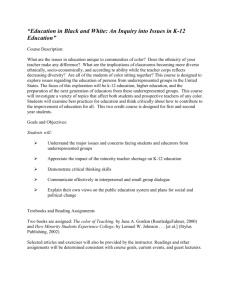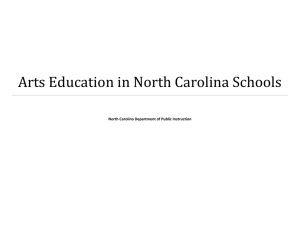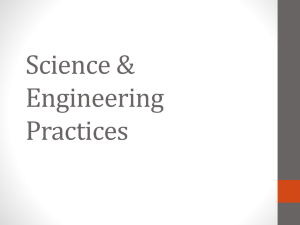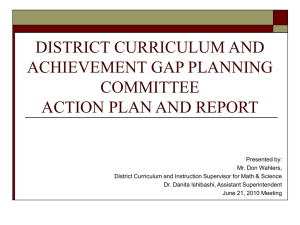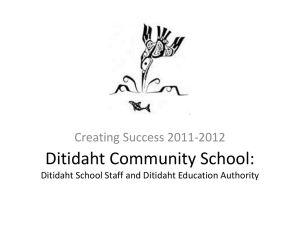1. mission - UBC Blogs
advertisement
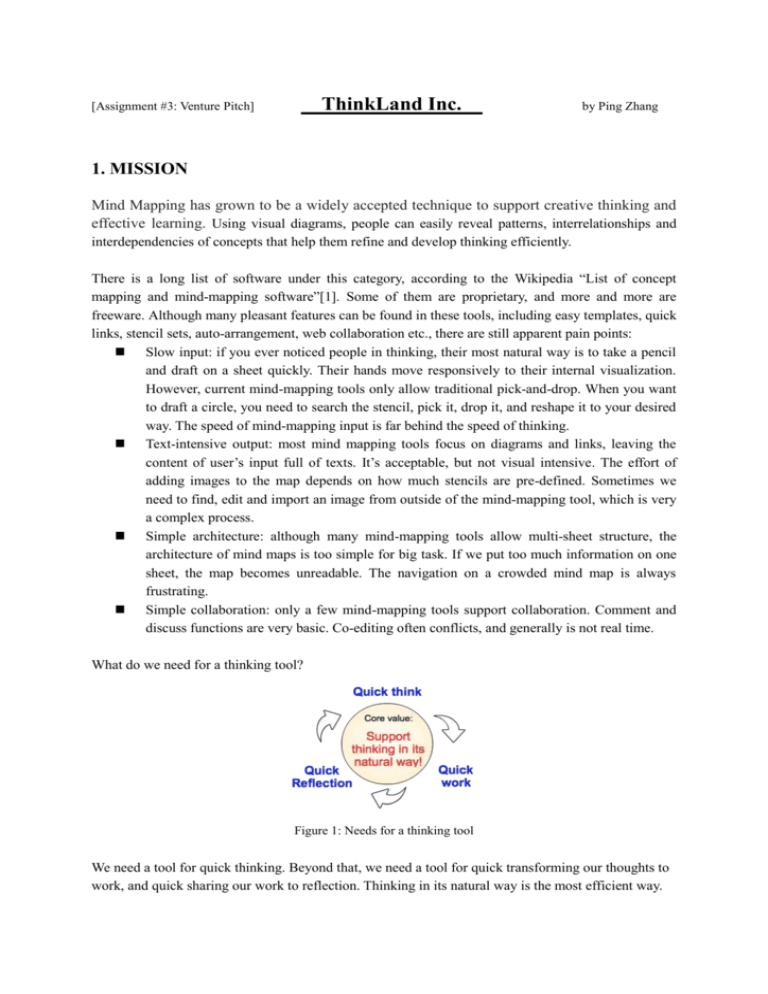
ThinkLand Inc. [Assignment #3: Venture Pitch] by Ping Zhang 1. MISSION Mind Mapping has grown to be a widely accepted technique to support creative thinking and effective learning. Using visual diagrams, people can easily reveal patterns, interrelationships and interdependencies of concepts that help them refine and develop thinking efficiently. There is a long list of software under this category, according to the Wikipedia “List of concept mapping and mind-mapping software”[1]. Some of them are proprietary, and more and more are freeware. Although many pleasant features can be found in these tools, including easy templates, quick links, stencil sets, auto-arrangement, web collaboration etc., there are still apparent pain points: Slow input: if you ever noticed people in thinking, their most natural way is to take a pencil and draft on a sheet quickly. Their hands move responsively to their internal visualization. However, current mind-mapping tools only allow traditional pick-and-drop. When you want to draft a circle, you need to search the stencil, pick it, drop it, and reshape it to your desired way. The speed of mind-mapping input is far behind the speed of thinking. Text-intensive output: most mind mapping tools focus on diagrams and links, leaving the content of user’s input full of texts. It’s acceptable, but not visual intensive. The effort of adding images to the map depends on how much stencils are pre-defined. Sometimes we need to find, edit and import an image from outside of the mind-mapping tool, which is very a complex process. Simple architecture: although many mind-mapping tools allow multi-sheet structure, the architecture of mind maps is too simple for big task. If we put too much information on one sheet, the map becomes unreadable. The navigation on a crowded mind map is always frustrating. Simple collaboration: only a few mind-mapping tools support collaboration. Comment and discuss functions are very basic. Co-editing often conflicts, and generally is not real time. What do we need for a thinking tool? Figure 1: Needs for a thinking tool We need a tool for quick thinking. Beyond that, we need a tool for quick transforming our thoughts to work, and quick sharing our work to reflection. Thinking in its natural way is the most efficient way. This is the vision taken by ThinkLand Inc. when it was born in this year. 2. SOLUTION ThinkLand Inc. provides a full cycle of platform for creative thinking. Respect to the thinking tools’ mission in above Figure 1, the solution of ThinkLand Inc. is consisted of three products: FreeThinker, FreeProject and FreeGroup. Figure 2: The solution of ThinkLand FreeThinker is a mind-mapping tool, which provides near-to-nature user interface for both input and output. Input to FreeThinkers can be freehand and ambiguous. The software will recognize the input and automatically map it to pre-defined shapes. Text-to-stencil is another important feature of FreeThinker, which helps the user with associated stencils or images as their input text, and organize the mind map in a visual intensive and relevant way. Figure 3: Product features After FreeThinker creates maps, FreeProject manages them. The organization of mind maps is highly hierarchical. Maps are linked in layer-of-detail. They are related in scape or chronologically. They can also relate to external resources, such as learning environment or media editors. Navigation on a FreeProject is as naturally as walking in a building, where each room (map) is presented in a neat way right serving its particular theme. During or after a project, a thinker shares his work on FreeGroup, which is a platform of real-time collaboration. Empowered by advanced network and telecommunication technology, FreeGroup enables real-time co-editing, auto-saving, instant messaging, and even voice conference which has never been provided in a collaboration software. Rich communication makes it possible for thinkers to collaborate in natural ways that will greatly accelerate the group thinking. The three parts of ThinkLand solution can be integrated or divided, according to application scenarios. Each of them can stand on a subdivided market competitively, but the integrated solution has the maximum power. 3. MARKET Figure 4: Market for ThinkLand The market for ThinkLand is very optimistic. There are 100 millions users in mind map market, that are still increased by 25% per year. The submarkets of K-12 and online users are the most potential targets in the early stage. Considering the fact that most available mind-mapping software are only accessed by PC (locally or via browser), the realistic market size for ThinkLand can be enlarged to 5 times to tablet and smartphone markets. The feature of freehand and ambiguous input of FreeThinker will show its value on these touchy devices and will win us a big advantage here. “Where and how buyers and users will be reached?” The answer might be difficult ten years ago, but not now. We have various approaches for media exposure. We can add ThinkLand introduction to Wikipedia. When people search for “mind mapping” tools, they will find us. It’s a simple but effective way because I use it myself. On the PC market, we can put entries of ThinkLand on the app stores hosted by channels, like Google Chrome. On the mobile market, app stores are mature. We can develop client apps for faster access from mobile than general browsers. Most buyers in this market are users themselves, while the K-12 market is a little different. Figure 5: Reach the buyers Reaching the users is a part of product design for ThinkLand. Users can access the in-cloud share space via different devices. The communication platform of FreeGroup allows seamless real-time experience for every user. Embedding ThinkLand into a 3rd party platform is a comprehensive task, guided by our partnership strategy, and based on efforts of both technology and economy. Figure 6: Reach the users In this prosperous but competitive market, why people choose ThinkLand instead of the others? We are different! In following figure we compare ThinkLand with its competitors representative in its target markets: Figure 7: Competition The innovative advantages of ThinkLand are highlighted in this figure. Text-stencil mapping is a very useful feature for K-12 education, when visual intensive stencils and images are highly required for children’s understanding. In schools supporting BYOD where many students study with tablets, they will like ThinkLand for its pleasant natural & smart input. The in-cloud shared publish space is more interactive and vivid than silent web classrooms. Hierarchically organized projects make the works easier to construct and navigate. In the K-12 market, learning support is critical for market success. ThinkLand has not advantage yet at present compare to specific K-12 ventures like Inspiration. ThinkLand will overcome this shortage by introduce partner cooperation, and do more research on K-12 oriented features. ThinkLand understands thinking, and facilitates thinking in its natural way. This core value stands on the back of all ThinkLand products, which contributes to its advantages at present, and will help it to keep them farther in this competitive market. 4. ASK & RETURN For an innovative venture like ThinkLand, analysis of the Ask and Return is very important. The following figure shows the technical and market readiness of this venture. Most features of three products are technical and market ready, stemmed on the professional background and R&D capability of the team. Input feature and K-12 Facilitations are under research. They will be available within a year. The technical risks of these products are under control. We also have roadmaps to arrange these features in progressive versions, and release them to the market in a strategical way. The research, development and marketing of these products will cost 2~3 millions each, that make an $8 millions gross asking for investment. The annual operation expense is $1 million in estimation; half of it will be used to run the real-time collaboration space in the cloud. Figure 8: Technical readiness, market readiness and estimated cost Our business model is flexible, which ensures a positive capital flow to support the venture and recompense investors. As shown in the figure below, the price strategy is rooted on free plan, which is more and more common in the mind-mapping market. The premium plan and team plan will charge users for advanced functions, such as unlimited input/output options, unlimited project resources, and wider range of collaborative support. Figure 9: The strategy for return Beside the License income described above, there are three other resources of avenue: Stencil Store, Template Store and Mindmap Store. People can use resources in these databases per pay. They can also contribute to these resources and get avenue share from other people’s references. When users of ThinkLand exceed 1 million, the estimate avenue of ThinkLand will over $20 millions per year. In an expanding market with billion users, the return prospect of ThinkLand is very optimistic. 5. THE TEAM Figure 10: The team ThinkLand is led by a passionate team full of professional credits. The founder and CEO of ThinkLand, Ping Zhang, is an architect for mobile telecommunication who has long time credits to design products over the network. She also has intensive academic background for computer-aided design and computer graphics, which helps her to deeply understand the design of visual-intensive application. The R&D group behind FreeThinker, FreeProject and FreeGroup is consisted of experts in different areas. The marketing group is led by vice president Kevin Elvilson, who has 20 years of marketing experience in online and professional markets. He shares the passion of Ping for K-12 education, and he has great interest to explore the new K-12 market. The team is also joined with partners in learning system and online society. They help ThinkLand to understand and explore these markets with better products and services. The team of ThinkLand Inc. invites you to join us! We are passionate and devoted to our mission, i.e. to support creative thinking in its natural way. We understand that thinking is the original power to push this world forward. With you investment, you can help us to develop a better platform for better thinking. Thank you! Refences: [1] http://en.wikipedia.org/wiki/List_of_concept_mapping_and_mind_mapping_software [2] http://www.inspiration.com [3] http://cacoo.com [4] http://wiki.ubc.ca/Visual-_Intensive_Learning [5] Farrand, Paul; Hussain, Fearzana and Hennessy, Enid (May 2002). "The efficacy of the 'mind map' study technique". Medical Education 36 (5): 426–431. [6] http://en.wikipedia.org/wiki/List_of_concept_mapping_and_mind_mapping_software [7] http://www.macworld.com/article/1002747/inspiration7.html [8] http://mindmappingsoftwareblog.com/why-mind-mapping-software-will-go-mainstream-in-2009


